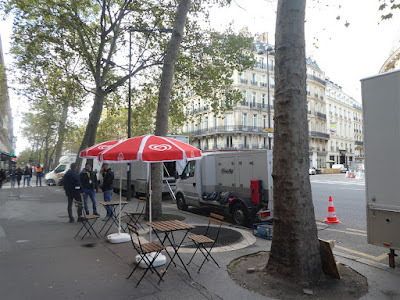Wagner's years in Paris, in the early1840s, as a struggling young composer, and in the early 1860s, when a new production of Tannhauser caused a scandal and a riot in the streets, were neither happy nor successful. His public gloating over France's defeat in the the Franco-Prussian war did not improve matters. But his works continued to be performed here, despite the two more wars with Germany, as much as any of the other greatest opera composers. And Wednesday night, October 6th, he triumphed again, with a symphonic program by the Orchestra de Paris, featuring selections from The Meistersingers of Nuremburg and Tristan and Isolde, and the entire first act of The Valkyrie, performed in oratorio fashion. And I was there for one of the most memorable performances I have heard. Vicki had found me a seat in the first row of the balcony behind the orchestra, where I could literally read the scores over the musicians' shoulders. It was a magical experience, the setting, the music, the performance, and, not least, the reaction of a genuinely enthusiastic and appreciative audience. Five curtain calls!
 |
The setting was the Paris Philharmonie, in the Cite de la Musique, in
Parc de la Villette, in the 19th, one of the world's newest musical venues |
|
 |
| Wide view of the Salle Pierre Boulez (the late composer and conductor); a hall in the modern orchestra-in-the-round shape, with moveable balconies, clouds, and other acoustic features that render amplification unnecessary; none of the 2,400 seats are more than 32 meters from the conductor; double-walled; see this article for much more on the hall |
 |
Knowing the music as well as I do, and being acquainted with a
variety of performances and recordings, certainly enhanced my
experience |
 |
As a former oboist, my eyes and ears were on his parts, here, as
customary, tuning the entire orchestra to A440
|
 |
The conductor, Jaap van Zweden...not too distracting as current
conductors go...seemed very popular with both musicians and
audience |
 |
At the intermission, the principal oboist places his reed in a reed-case
(ask me sometime about oboe reeds) |
 |
| Tuning up again |
 |
After the glorious coda with Sigmund and Sieglinde and during the
applause and bravos and repeated curtain calls, the conductor
recognizes different soloists and sections of the orchestra: here the
six harpists required for The Valkyrie |
 |
| A glorious evening: thank you for encouraging me, Vicki! |



























































